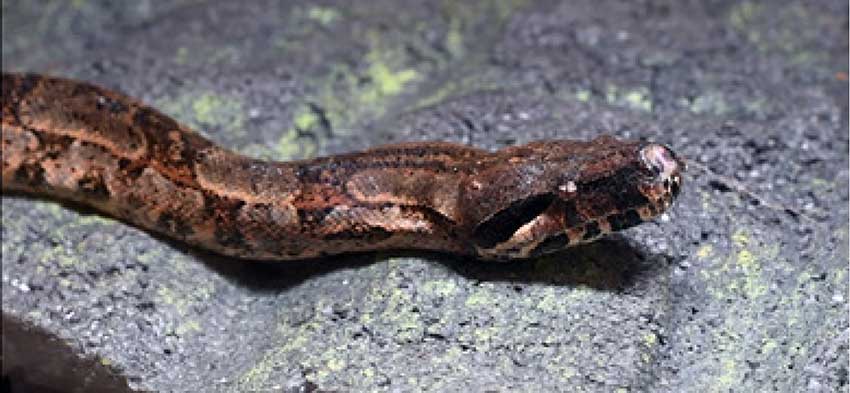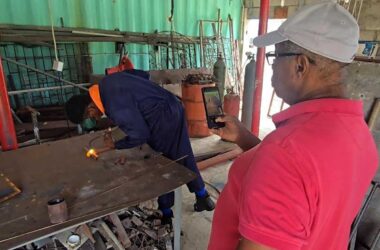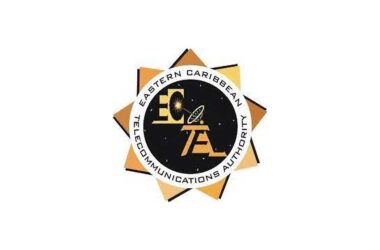
The Universal Health Coverage (UHC) Unit launched a Snakebite Management initiative on Thursday as the latest service under UHC. The service includes preventive measures, antivenom, medication, laboratory tests, imaging studies, surgery (if required), outpatient clinic review, physiotherapy, and hospitalization costs.

“We are quite happy about this because we know that it will be of tremendous benefit to farmers, persons who live and work in snake habitats… even our foresters,” Assistant Chief Forestry Officer, Pias Haynes, said.
“We have a number of foresters who work in snake habitats – for example, in Millet, Dennery and even in Soufriere. What we have noticed in the recent past is that we are now getting fer-de-lance encounters in areas or places where we had not seen them before. This is a matter of concern to us as a Forestry Department and… we need to take steps to help educate the public in the fight against snakebites,” he added.
On average, a fer-de-lance injects 105mg of venom in one bite, although 310mg has been recorded, ‘Better Planet Education’ noted in an online post.
Haynes said, “As we speak, we are getting encounters of fer-de-lance in places like Soufriere… and even Edmund Forest. Also, on the East Coast: places like Bois Jolie… Thomazo and Morne Panache. Residents are now reporting snake encounters in these areas and it was something that we were not seeing before. This could be attributed to a number of things. It could be… an increase in the population [and] there could be a displacement [as well].”

Fer-de-lance sightings were not as common before. In fact, “Snakes were more contained in their… habitat so… we indeed have a reduction,” Haynes said.
Moreover, he noted, “We have less farming happening and what we have observed is that the areas where bananas were once planted… the fer-de-lance … is now coming into those areas and they are getting closer to human habitation. We would like to [send] the message to our farmers [and] persons who live in snake habitats to be extremely careful. There needs to be a very high level of vigilance.”
He also provided a number of tips to assist the public.
“Ensure your vegetation is well managed, grasses are kept low, and if you want to apply herbicide [ensure]the area is kept clean and clear… because… the fer-de-lance loves places where it can get shelter. For example, if you have piles of wood, discarded coconuts… these kinds of things,” he said.
Geber Ferdinand, a local firefighter, warned individuals to stay away from home remedies.
“We respond to calls and we get a lot of persons who use home remedies like… alcohol, jeyes, turpentine [and] kerosene on bites. We need people to refrain from doing those things. The main thing that we need people to do is… try to get to the hospital as quickly as possible. We advise persons not to walk… it allows… the venom to travel through the muscles a lot faster. Some persons have tried cutting the wound… to bleed it out,” but that does not help, he said.
Furthermore, if you’ve been bitten by a snake, do not tie the wound with a cloth as it does further damage.
“A lot of persons tie [the wound]… and all they do is compartmentalize what happens. They cut off the blood supply and the venom stays in one part of the body. It causes so much damage to that part of the body that it is often amputated or… is no longer… able to [be used]. If you have help, [ask] someone [to]carry you to a safe place, await the ambulance or get private transportation if it’s quicker. Remember… treatment is free under Universal Healthcare,” he said.
According to the Centers for Disease Control and Prevention (CDC), signs or symptoms of a snake bite can vary depending on the type of snake.
Around the wound, an individual may experience:
– Severe pain and tenderness
– Bleeding, redness, swelling, bruising, or blistering. (Puncture marks can also appear).
After the bite, one can experience:
– Nausea, vomiting, or diarrhea
– Trouble seeing or breathing. (In extreme cases, breathing may stop).
– Rapid heart rate, weak pulse, low blood pressure
– Metallic, mint, or rubber taste in the mouth
– Increased salivation and sweating
– Numbness or tingling around the face and/or limbs
– Muscle twitching
“The main thing is to seek help as quickly as possible. Go to… OKEU or… down to St. Jude because that’s where the anti-venom is available right now. The health centres don’t have it so try your best… to get to a main hospital on island,” Ferdinand warned.
According to the CDC, individuals should do the following if they’ve been bitten:
– Seek emergency medical attention as soon as possible to start antivenom (if needed) and stop irreversible damage.
– Do not drive yourself to the hospital because the snakebite can make you dizzy or pass out.
– Take a photograph from a safe distance to identify the snake if possible, which may aid in faster treatment.
– Keep calm.
– Lay or sit with the bite in a neutral position of comfort.
– Remove rings and watches before swelling starts.
– Wash the bite with soap and water.
– Cover the bite with a clean, dry dressing.
– Mark the leading edge of tenderness/swelling on the skin and write the time alongside it.
Do not do any of the following:
– Do not pick up the snake or try to trap it.
– Never handle a venomous snake, even a dead one.
– Do not wait for symptoms to appear; get medical help right away.
– Do not apply a tourniquet, electric shock, or folk therapies.
– Do not slash the wound with a knife or cut it in any way.
– Do not try to suck out the venom.
– Do not apply ice or immerse the wound in water.
– Do not drink alcohol as a painkiller or take pain relievers (such as aspirin, ibuprofen, naproxen).













